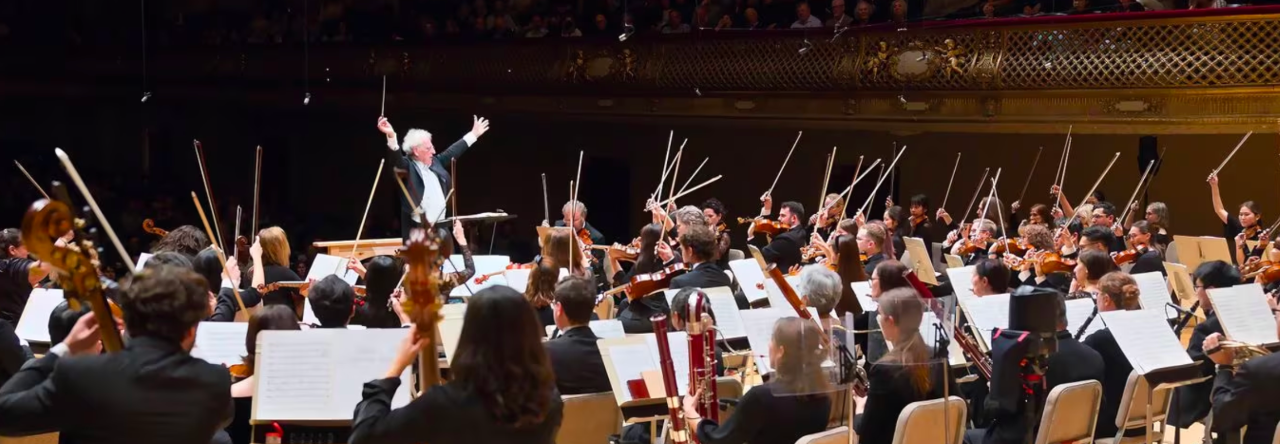Boston Philharmonic Orchestra presents an emotional, exhilarating evening with unexpectedly tender conclusions

On an emotional evening Friday at Symphony Hall, the Boston Philharmonic Orchestra presented a program of uplifting musical farewells alongside works of profound psychological despair. Bartók’s cheerful Piano Concerto No. 3, featuring a sparkling Benjamin Hochman as soloist, and a beloved concert-closing encore buoyed the audience’s spirits amid searing performances of Britten’s Passacaglia from “Peter Grimes” and Shostakovich’s Symphony No. 10.
In opening remarks, music director Benjamin Zander dedicated the performance to his former wife and lifelong friend Rosamund Stone Zander, who died in September. Ms. Zander, he shared, had been the “inspiration and spiritual guide” for the orchestra since its founding 45 years ago. He portrayed the program’s stark juxtaposition of light and darkness as a reflection of her ability to offer solace and “coax harmony from the discords of life.”
Bartók’s Piano Concerto was a breath of summer air, a respite from the other works and the November gusts outside. Written by an ailing Bartók for his wife, Ditta, right up until his passing, it conveys an exhilarating love of life even in the face of personal tragedy.
Hochman led the work with refreshing calm, clarity, and friendliness: almost every note seemed to wear a smile. In his hands, the opening melody with its unpredictable warbles felt like a natural conversation starter. And the Philharmonic proved a receptive partner, particularly in the second movement’s “Andante religioso,” where gorgeously blended chorale textures from strings, winds, and soloist were carried by a gentle breeze. Against this backdrop, the nature sounds of the movement’s middle section, usually considered a classic example of Bartók’s “night-music,” readily evoked the coming of dawn.
In the finale, the orchestra brilliantly executed Bartók’s swings from folk dance to Baroque dance, so that Hochman’s return to the stage for a Bach Sarabande was a perfect companion. Indeed, Hochman’s encore demonstrated enlightening continuity with his approach to the Bartók, respecting the integrity of each individual tone and embracing the silences in between them.
The program opened with Britten’s Passacaglia, an interlude from the opera “Peter Grimes” that vividly depicts its title character’s descent into madness. The cellos and basses kept their plucked skeleton buried deep beneath the vulnerable, yearning viola solo, heartbreakingly intoned by Noriko Futagami, but the motto never lost its bone-chilling clarity as the music grew to terrifying heights. Zander, with relentless forward momentum, riveted his listeners’ attention to that bassline even as fanfares, taunts, and squeals erupted from every direction.
That sense of focused dread returned in full force for Shostakovich’s symphony. Shostakovich casts much of his extremely long opening movement in shadow, but the Philharmonic’s shadows advanced searchingly rather than wallowing in desolation. Rane Moore’s longing clarinet seemed to blossom directly from the winding melodies the strings gathered in the darkness. Her tune led off a superb all-around effort by the winds and brass, featuring Rachel Braude’s masterful piccolo, Kevin Owen’s mysterious horn calls, and the unbearable loneliness of the final movement’s opening laments passed between oboe, flute, and bassoon. The first movement’s earth-shattering climaxes felt like the Philharmonic was playing the entire hall as an instrument: Shostakovich’s characteristic interplay between blistering high notes and menacing low brass became a richly textured crunch rather than just a wall of sound.
In the frenetic second movement, the orchestra created the exhilarating feeling that things might fly off the handle even as it displayed impressive technical precision. On the podium, Zander thrillingly conveyed that danger, bobbing and crouching as if desperate to keep Shostakovich’s terror under control. That desperation left an impression on the rest of the performance, from the spiky devil’s dances of the third movement to the white-knuckle finale. Shostakovich’s ultimate assertion of individual freedom in his first symphony after Stalin’s death was convincingly delivered by the orchestra, not least by the horn section’s jaw-dropping blasts, spurring the audience to its feet.
But Zander left us by returning to his opening tribute. After sharing some of his former wife’s defining words of wisdom, he selected Elgar’s “Nimrod” from his Enigma Variations as a way of celebrating her life and friendship. The conductor and his orchestra rendered the work with warm, serene familiarity, bringing the evening to an unexpectedly tender conclusion.
Click here to read the program.
 Leo Sarbanes - The Boston Globe
Leo Sarbanes - The Boston Globe